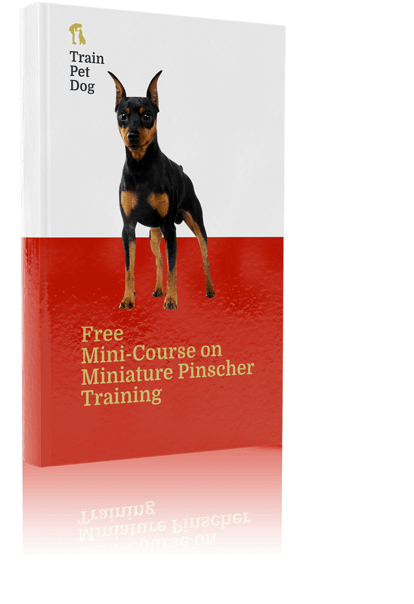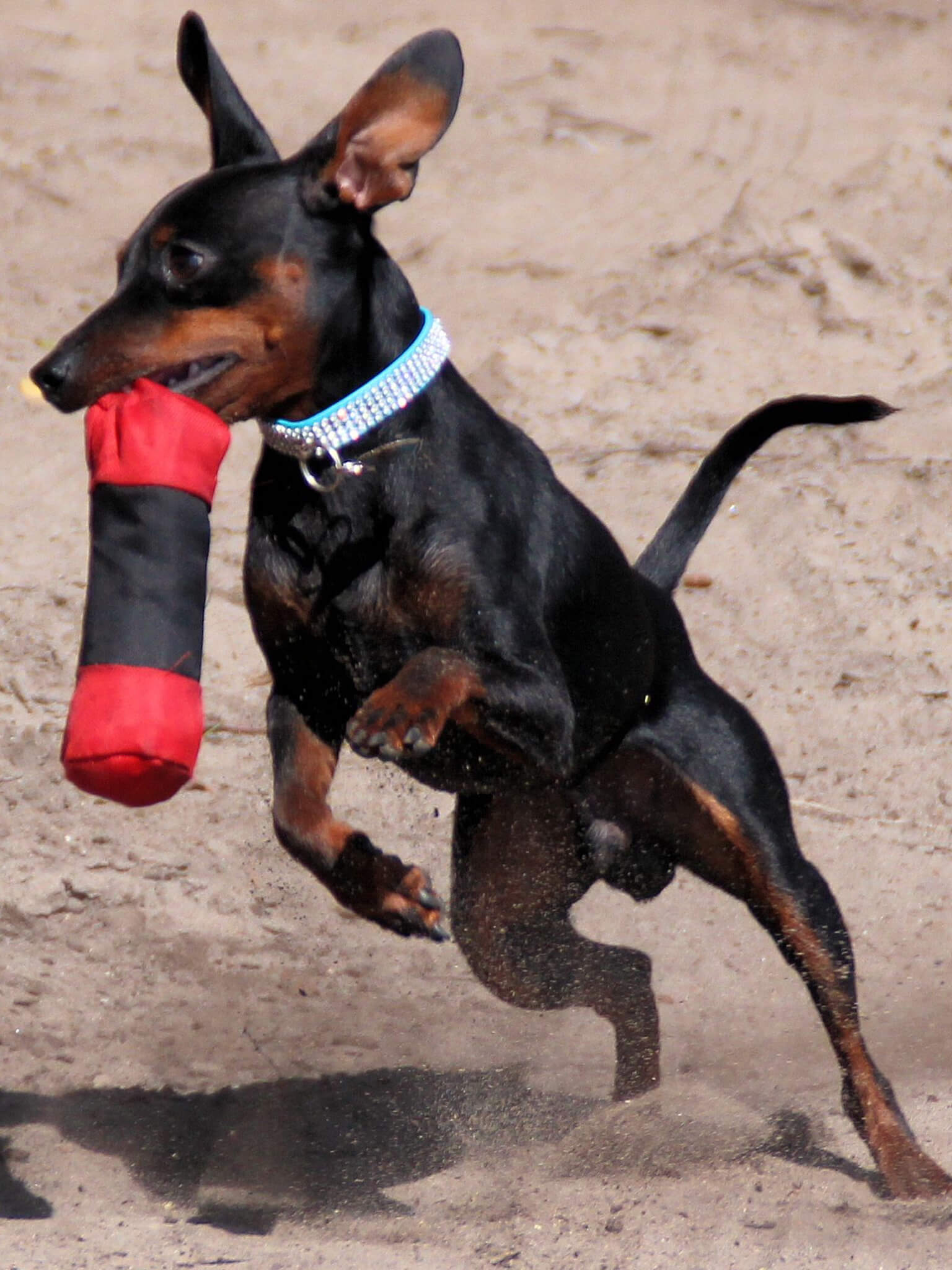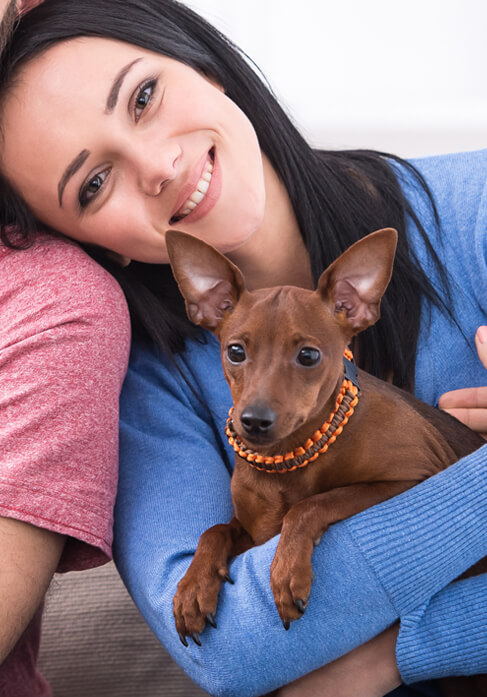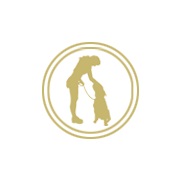Privacy Policy: Your email address is 100% safe.
We don't spam and hate it as much as you do :-) You can also unsubscribe from our mailing list at any time.

Sign Up
Miniature Pinscher: Key Characteristics of Dog Breed (MinPin)

Country of Origin, History of Miniature Pinschers
This Breed of dog originated in Germany and is not related to the Doberaman Pinscher. This is older than the Doberman Pinscher and its existence can be traced back to the 17th century. The breed descended from the Terrier breeds of Germany, which were used by farmers primarily to hunt rats in farms and stables. The word Pinscher is a German word meaning Terrier.
Miniature Pinscher is a cross between the German Pinscher, Dacshund and the Italian Greyhound. The breed was brought to the United States in the 1920s and became popular as a loving companion, across America within a short span.
Miniature Pinscher Tools
Breed Selector Tool - is the Miniature Pinscher the right breed for you?
Is the Miniature Pinscher the right breed for you and your family?
Find out by using our Free Dog Breed Selector Tool
Check Your Miniature Pinscher's Learning Style
Are you aware dogs also have a learning style that can greatly affect their ability to housetrain as well as be trained correctly. Evaluate your Miniature Pinscher's learning style and personality using our free Learning Style tool so that you are better able to provide him with the proper Miniature Pinscher training methods.
Is your Miniature Pinscher dominating over you?
Does your Miniature Pinscher bark unnecessarily? Does your Miniature Pinscher come to you when you call? Download a FREE Report on Dog Dominance for you and your Miniature Pinscher and learn how to control your dog.
Do you make these mistakes with your Miniature Pinscher?
Are you inadvertently snow-balling bad behavior in your Miniature Pinscher? Evaluate your Dog Training Style from our Free Tool and learn how best to deal with your dog.
Miniature Pinscher Calorie Calculator
Do you know how many calories your Miniature Pinscher needs every day and how many cups of food you should be giving it every day? Click here to use our Miniature Pinscher Calorie Calculator.

A General Appearance of the Dog
The Miniature Pinscher is a muscular, sturdy dog with a square, proportioned body. The dog has a flat, tapering skull and docked tails and cropped, erect ears. The dog has a well-balanced arched neck with a level topline. Pinschers have very dark, big expressive eyes and are elegant to look at.
Coat Color
Their coat color varies from solid red, stag red (with black hairs in between), to black-and-rust, or chocolate-and-rust.
Coat Type
The coat type is smooth, short, straight and hard in texture.
Weight: 8-10 lbs for both males and females
Height
Male : 10-12 inches
Female : 10-12 inches



Free Miniature Pinscher Training Secrets
Free Course on Miniature Pinscher Training & Obedience
Stop All Bad Behavior, Excessive Barking and Biting
Miniature Pinscher Personality Traits

Temperament of the Dog
This dog is sturdy, bold, fiery and proud. Pinschers are extremely agile and spirited dogs. They might be given to excessive barking. They are devoted and protective towards their masters. Their alertness makes them a good watchdog. These dogs need to be socialized from a very young age since they detest strangers and are often aggressive towards other dogs. Pinschers are inteligent and can be trained without much of a hassle.
Pinshers might develop behavioral problems if they are not handled firmly since these dogs might become temperamental and demanding.
Good with other dogs/ and other animals?
Pinschers need socialization from a very young age since they have a habit of getting on te wrong side of other dogs and animals.
Good with children?
They are good with small children but contant teasing can make them snappy. Households with matured adults can own Pinschers.
Better suited to an indoor or outdoor lifestyle?
They do best in households with yards to romp around freely. They have a habit of exploring surroundings and hence, the yards should be fenced. They are also active indoors.
Miniature Pinschers are sensitive to cold.
What kind of home would they do best in – one with kids, or any such specifications?
They are friendly with older children and the elderly.
Training
A Greyhound puppy should be trained on a leash and given verbal praise, correction, and food rewards. This breed becomes upset with physical discipline. The dog puppy should be exposed to various sights and sounds, and all training needs to be consistent and administered by a patient guardian. This breed is difficult to housebreak and requires consistent crate training and a doggy door for outside access. This dog puppy may resist going out into cold weather or rain; as a result, a guardian needs to use consistent phrases, rewards, and verbal praise when training the dog to go outside.


Free Miniature Pinscher Training Secrets
Free Course on Miniature Pinscher Training & Obedience
Stop All Bad Behavior, Excessive Barking and Biting
Miniature Pinscher Activity Level
How active is the breed?
They are an active and agile breed and need regular
exercise. Moreover, they should be execised at least
twice a day. Owners should take them out on a leash
to prevent their exploring tendencies, which might
even prove to be fatal.
How much exercise does the dog need at every stage of its life?
Pups should be dissuaded from over exercising themselves as it might even maim them permanently as they have a fragile bone structure.
Is your Miniature Pinscher causing you trouble by eliminating inside your house? Get our Free tips on Housebreaking your Miniature Pinscher and put an end to all the housetraining nightmares - permanently.
Training your Miniature Pinscher can be fun and a rewarding experience for both you and your dog. Get step-by-step tips on Miniature Pinscher Training – now.
How to take care of a Min Pin Puppy?
Pinscher Puppies are so small that they often roam around unnoticed. Removal of hazardous chemicals, cords out of their reach is a must. Moreover, rampant breeding has resulted in a fragile bone structure for the breed. Overexercising might injure them beyond recovery. They should receive adequate rest. Nutrient-rich meals should be fed daily at fixed times.
Puppies should be taught to remain in their crates until they are asked to come out of it. A spacious crate should be provided to pups. Proper hygiene should be maintained. Vaccination and de-worming schedules need to be strictly adhered to. A vet is to be consulted in case of any crisis.
Toy breeds can become hypoglycemic if their sugar levels fall. To retain sugar proper levels, owners should feed them with doses of Nutri-cal.
If you have a Miniature Pinscher dog or puppy at home and you want to train it into the most loving pet, Sign-up for our Free Miniature Pinscher Training Course.
Grooming
Minature Pinschers do not require much grooming. Their ears and eyes should be cleaned regularly. Their nails are be clipped to avoid accidents. They should be bathed only when it is absolutely necessary and should be wiped with a damp towel occassionally. Anal glands have to be expressed by a vet carefully at intervals.
Grooming your dog yourself, at your home and at your convenience will help you build a strong bond with your Miniature Pinscher. You will not only save yourself the hassle of taking him to a groomer regularly, you save some money too.


Free Miniature Pinscher Training Secrets
Free Course on Miniature Pinscher Training & Obedience
Stop All Bad Behavior, Excessive Barking and Biting
Health and Care
While the SWD seems to be a very healthy breed there are some issues that the SWD have, just like all other breeds. There are cases of Hip Dysplasia in the breed, so choose your breeder carefully.
All breeding dogs should have their hips tested, either by OFA or PennHIP. There have been a few cases of PRA reported in Europe so it is advised that all breeders should test their breeding stock for PRA and other such genetic eye diseases with a yearly CERF exam. A responsible breeder will be able to produce the results in writing.
Like other Water Dogs and related breeds, they grow hair in their ear canals and can be prone to ear infections. The ears must be kept dry and clean. . Because these dogs are (as a general rule) so active and energetic as puppies, they may seriously injure themselves from too much running and jumping when their skeletal structure is still developing.
National Breed Clubs
National Breed Club:
U. S. – Miniature Pinscher
Club of America – http://www.minpin.org
British – Miniature Pinscher Club –
http://www.miniaturepinscherclub.co.uk
Recognition: CKC, FCI, AKC, UKC, KCGB, CKC, ANKC, NKC, NZKC, APRI, ACR.
Train Your Miniature Pinscher To Listen To You
Get Instant Access to Your Training Now - For Free
Sign up for our Free Miniature Pinscher Mini Course to have a housebroken, obedient dog that happily comes to you every time you call.
You'll learn new commands to obedience-train your dog as well as how to housebreak your dog in 6 days or less.
You'll also learn how to eliminate bad habits like barking, nipping or biting, jumping, or pulling on the leash.Here's just s small fraction of what else you'll learn in the course:
How to lead and think like a pack dog - the new psychology.
3 dangerous mistakes that most Min Pin owners make when they are trying to potty train their dogs.
The 2 main reasons why your dog barks excessively and how to control its excessive barking.
How to obedience train your Miniature Pinscher to permanently end behavioral problems like Jumping, Aggression, Pulling on Leash.
A surprisingly easy way to teach your dog cool new tricks.
How to improve your dog's lifespan and keep it from getting overly heavy with a healthy and nutritious diet.
Getting Pro help fast - how to get access to our expert trainers when you need them most.
One hidden psychological trigger that all Miniature Pinschers have... that practically allows you to "analyze" and "control" your dog's every action.
Priority access to the free online seminars conducted by our training experts.
Whereas other dog training related web sites and books offer generic information for dogs in general, ours is the ONLY web site that offers Min Pin information specifically, from a renowned panel of experts - because as you probably know, Min Pins have their own special training requirements that other dogs don't have.
Our Dog Experts
The Miniature Pinscher training information you will read here was developed by a panel of renowned dog training experts whose combined wisdom represents nearly 100 years of specialist experience training dogs.
Here are a few of our experts:




